In Photos: Reunions between Korean families divided by war
Past reunions, some televised, have often unleashed floods of tears, with face-to-face encounters ending in painful separations. The last reunions were held in 2015. The South has also sought to resume video conferences and the delivery of letters among families divided by the border.
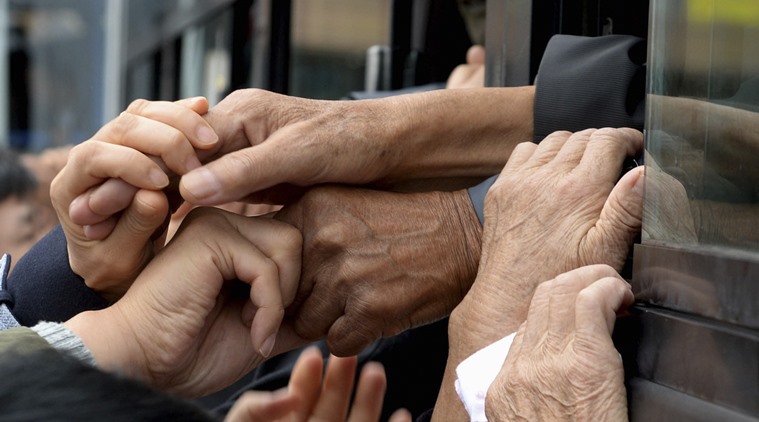
South Koreans and their North Korean relatives on a bus grip their hands each other to bid farewell after the Separated Family Reunion Meeting at Diamond Mountain resort in North Korea. (Source: AP)
North and South Korean officials met on Friday to map out details for what would be a highly emotional reunion of families separated since the 1950-53 Korean War. The Korean leaders in their first meeting agreed to hold the family reunions around Aug. 15, an anniversary celebrated in both countries marking the Korean Peninsula’s independence from Japanese colonial rule at the end of World War II in 1945.
Since the end of the Korean War, both Koreas have banned ordinary citizens from visiting relatives on the other side of the border or contacting them without permission. Nearly 20,000 Koreans had participated in 20 rounds of face-to-face reunions held between the countries since 2000.
1m 33s
The effort is among the steps promised by North Korean leader Kim Jong Un and South Korean President Moon Jae-in to improve relations that had deteriorated over the North’s nuclear and missile programmes.
Past reunions, some televised, have often unleashed floods of tears, with face-to-face encounters ending in painful separations. The last reunions were held in 2015. The South has also sought to resume video conferences and the delivery of letters among families divided by the border.
A look at key issues:
MILLIONS SPLIT BY WAR
After the conflict ended with an armistice, not a peace treaty, the two Koreas banned millions of people who found themselves suddenly divided from visiting each other’s territory across the world’s most heavily fortified border. Decades later, most have no word on whether their loved ones are still alive — their governments prohibit even exchanging letters, phone calls and emails. Most of the separated family members are now in their 70s and older and eager to reunite with their long-lost relatives before they die. In South Korea, more than half of the 132,124 people who applied for past reunions have died.
After the conflict ended with an armistice, not a peace treaty, the two Koreas banned millions of people who found themselves suddenly divided from visiting each other’s territory across the world’s most heavily fortified border. Decades later, most have no word on whether their loved ones are still alive — their governments prohibit even exchanging letters, phone calls and emails. Most of the separated family members are now in their 70s and older and eager to reunite with their long-lost relatives before they die. In South Korea, more than half of the 132,124 people who applied for past reunions have died.
ON-AND-OFF REUNIONS
There was a one-time, small-scale reunion in 1985. But the reunions in their current form were first held in 2000 after the leaders of the two Koreas held a first-ever summit earlier that year. About 23,520 Koreans have had their meetings together since 2000 — some 19,770 in person and the others by video. Most of the 20 face-to-face reunions were held at the North’s scenic Diamond Mountain resort, the likely site for the next reunion. The last such event was held in 2015. Participants were typically given three days to spend with their relatives and parted again for good after their brief encounters. No Korean has ever been given a second chance to see their relatives from the other side.
There was a one-time, small-scale reunion in 1985. But the reunions in their current form were first held in 2000 after the leaders of the two Koreas held a first-ever summit earlier that year. About 23,520 Koreans have had their meetings together since 2000 — some 19,770 in person and the others by video. Most of the 20 face-to-face reunions were held at the North’s scenic Diamond Mountain resort, the likely site for the next reunion. The last such event was held in 2015. Participants were typically given three days to spend with their relatives and parted again for good after their brief encounters. No Korean has ever been given a second chance to see their relatives from the other side.
TEAR-JERKER
In past reunions, elderly Koreans wept, embraced and stroked each other’s cheeks in a rush of words and emotions. Some exchanged gifts like long johns, liquor and photographs of relatives who couldn’t attend or had died, while others struggled to continue their conversations. They included women who had never remarried and were briefly reunited with husbands who had new families, and those who met relatives they assumed had already died and had memorial services held for them. North Koreans typically wore almost identical clothes: men in dark suits, ties and bowler hats and women in Korean traditional “hanbok” dresses. During tearful separations at the end of three days, many aboard buses extended their hands out the windows to hold their relatives’ hands one last time.
In past reunions, elderly Koreans wept, embraced and stroked each other’s cheeks in a rush of words and emotions. Some exchanged gifts like long johns, liquor and photographs of relatives who couldn’t attend or had died, while others struggled to continue their conversations. They included women who had never remarried and were briefly reunited with husbands who had new families, and those who met relatives they assumed had already died and had memorial services held for them. North Koreans typically wore almost identical clothes: men in dark suits, ties and bowler hats and women in Korean traditional “hanbok” dresses. During tearful separations at the end of three days, many aboard buses extended their hands out the windows to hold their relatives’ hands one last time.
WHO CAN ATTEND
South Korea uses a computerized lottery system to pick participants, while observers believe North Korea chooses only citizens seen as loyal to its authoritarian government. Some South Koreans said they were surprised after seeing their North Korean relatives praising their ruling Kim dynasty even during private meetings at hotel rooms. South Korea has long pushed for more reunions, but North Korea is reportedly reluctant to do so because it worries the expansion of its citizens’ contacts with more affluent South Koreans could eventually loosen its grip on power. The North has also often tried to win aid and concessions from South Korea for allowing reunions.
South Korea uses a computerized lottery system to pick participants, while observers believe North Korea chooses only citizens seen as loyal to its authoritarian government. Some South Koreans said they were surprised after seeing their North Korean relatives praising their ruling Kim dynasty even during private meetings at hotel rooms. South Korea has long pushed for more reunions, but North Korea is reportedly reluctant to do so because it worries the expansion of its citizens’ contacts with more affluent South Koreans could eventually loosen its grip on power. The North has also often tried to win aid and concessions from South Korea for allowing reunions.
For all the latest World News, download Indian Express App

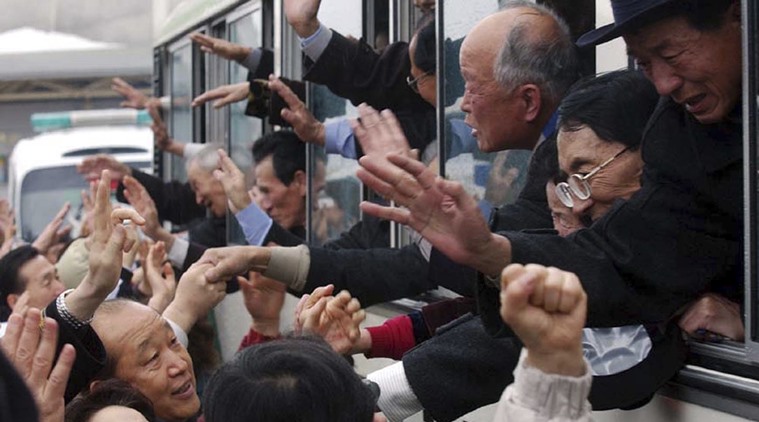 The Koreas last held family reunions in 2015 before relations worsened because of North Korea’s accelerated pursuit of nuclear long-range missiles. (Source: AP)
The Koreas last held family reunions in 2015 before relations worsened because of North Korea’s accelerated pursuit of nuclear long-range missiles. (Source: AP)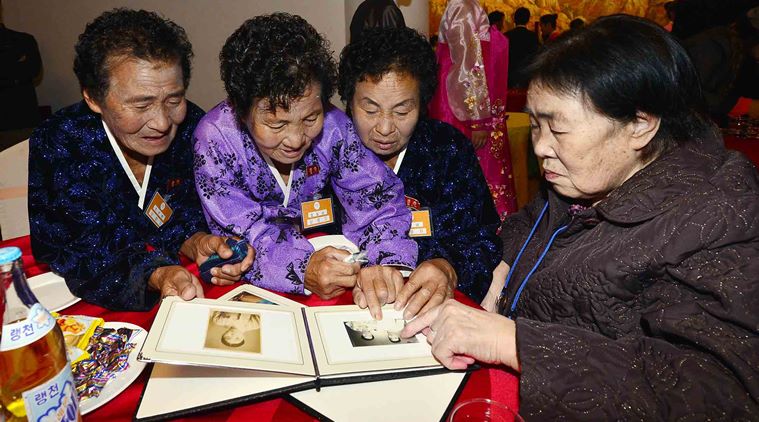 In this Oct. 25, 2015, file photo, South Korean Jo Soon-jeon, 83, right, looks at the family photos with her North Korean sisters during the Separated Family Reunion Meeting at the Diamond Mountain resort in North Korea. (Source: AP)
In this Oct. 25, 2015, file photo, South Korean Jo Soon-jeon, 83, right, looks at the family photos with her North Korean sisters during the Separated Family Reunion Meeting at the Diamond Mountain resort in North Korea. (Source: AP)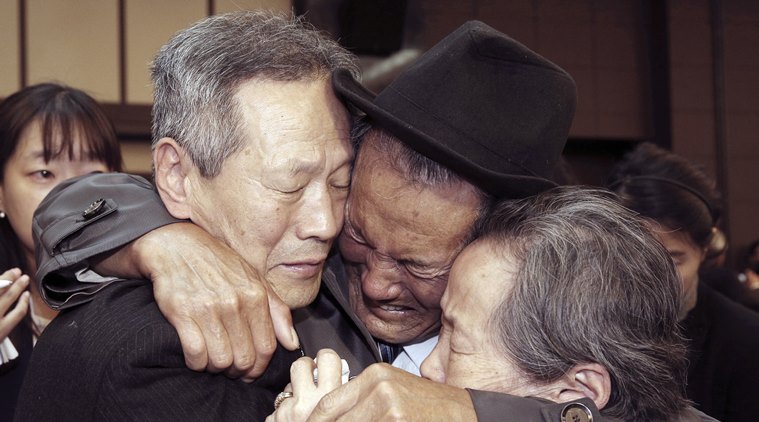 The 1950-53 Korean War was concluded only with a truce, not a peace treaty, leaving the combatants technically still at war. (Source: AP)
The 1950-53 Korean War was concluded only with a truce, not a peace treaty, leaving the combatants technically still at war. (Source: AP)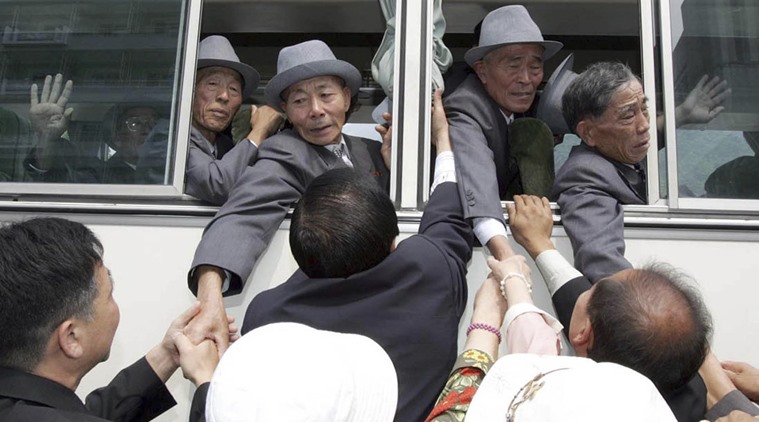 South Korea uses a computerized lottery to pick participants for the reunions, while North Korea is believed to choose based on loyalty to its authoritarian leadership. (Source: AP)
South Korea uses a computerized lottery to pick participants for the reunions, while North Korea is believed to choose based on loyalty to its authoritarian leadership. (Source: AP)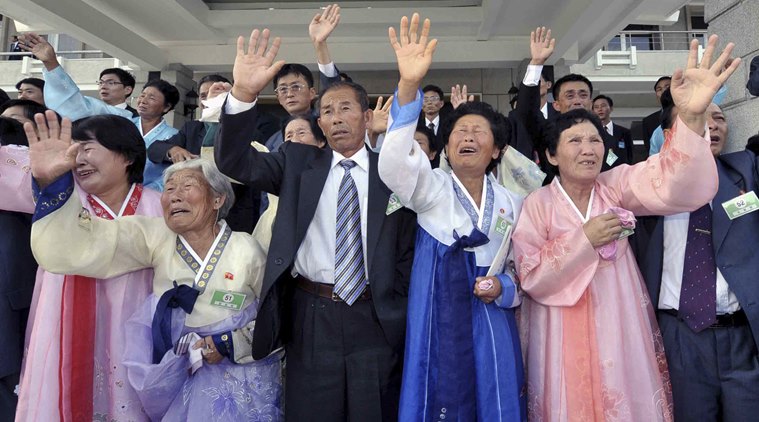 Since 2000, about 23,676 separated Koreans, from both North and South, have met or interacted through video link as part of the programme, the Hyundai Research Institute thinktank said. (Source: AP)
Since 2000, about 23,676 separated Koreans, from both North and South, have met or interacted through video link as part of the programme, the Hyundai Research Institute thinktank said. (Source: AP)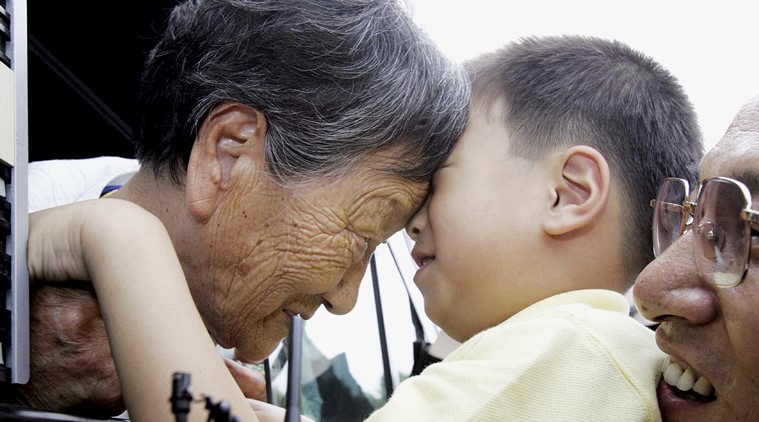 Reunion programs are highly emotional as most wishing to take part are elderly people who are eager to reunite with their loved ones before they die. (Source: AP)
Reunion programs are highly emotional as most wishing to take part are elderly people who are eager to reunite with their loved ones before they die. (Source: AP)




































No hay comentarios:
Publicar un comentario